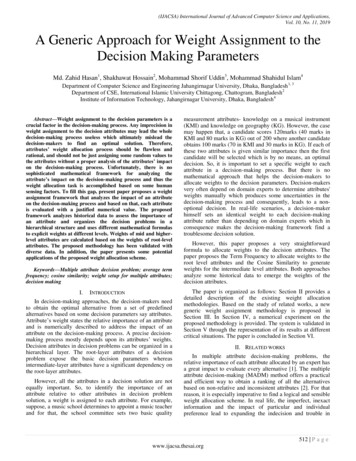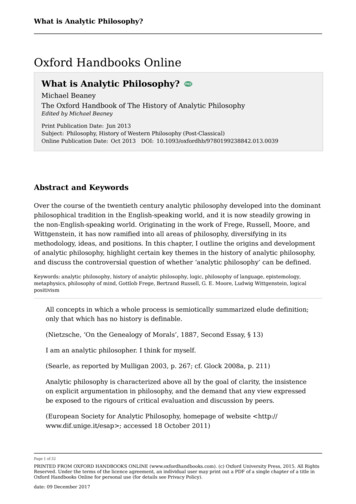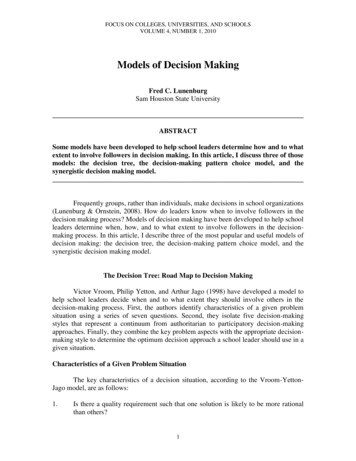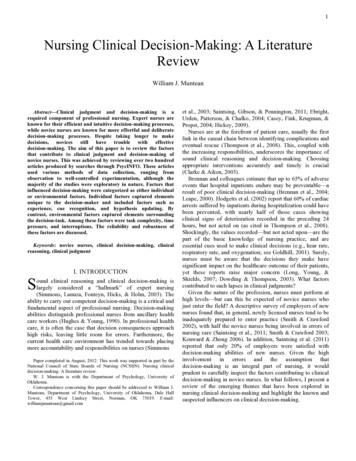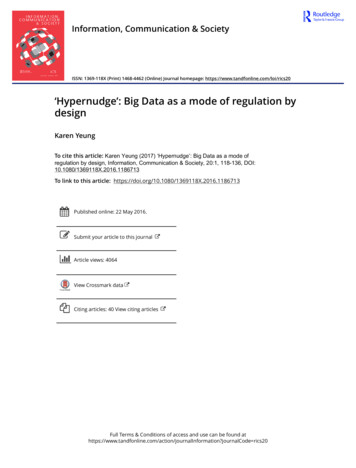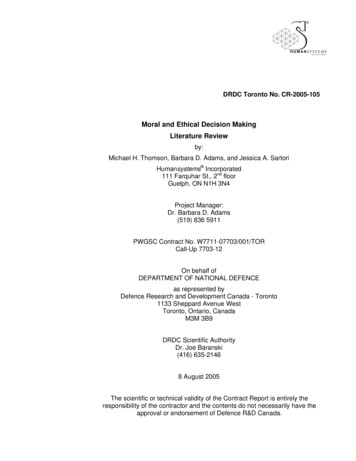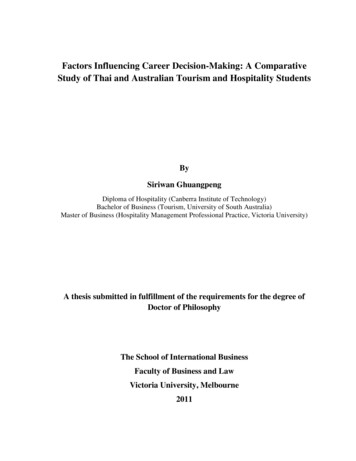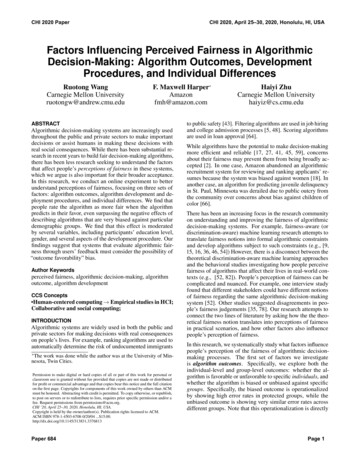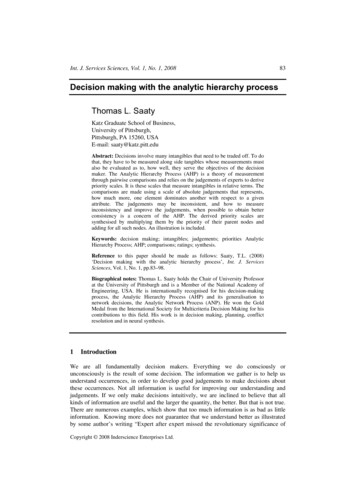
Transcription
Int. J. Services Sciences, Vol. 1, No. 1, 200883Decision making with the analytic hierarchy processThomas L. SaatyKatz Graduate School of Business,University of Pittsburgh,Pittsburgh, PA 15260, USAE-mail: saaty@katz.pitt.eduAbstract: Decisions involve many intangibles that need to be traded off. To dothat, they have to be measured along side tangibles whose measurements mustalso be evaluated as to, how well, they serve the objectives of the decisionmaker. The Analytic Hierarchy Process (AHP) is a theory of measurementthrough pairwise comparisons and relies on the judgements of experts to derivepriority scales. It is these scales that measure intangibles in relative terms. Thecomparisons are made using a scale of absolute judgements that represents,how much more, one element dominates another with respect to a givenattribute. The judgements may be inconsistent, and how to measureinconsistency and improve the judgements, when possible to obtain betterconsistency is a concern of the AHP. The derived priority scales aresynthesised by multiplying them by the priority of their parent nodes andadding for all such nodes. An illustration is included.Keywords: decision making; intangibles; judgements; priorities AnalyticHierarchy Process; AHP; comparisons; ratings; synthesis.Reference to this paper should be made as follows: Saaty, T.L. (2008)‘Decision making with the analytic hierarchy process’, Int. J. ServicesSciences, Vol. 1, No. 1, pp.83–98.Biographical notes: Thomas L. Saaty holds the Chair of University Professorat the University of Pittsburgh and is a Member of the National Academy ofEngineering, USA. He is internationally recognised for his decision-makingprocess, the Analytic Hierarchy Process (AHP) and its generalisation tonetwork decisions, the Analytic Network Process (ANP). He won the GoldMedal from the International Society for Multicriteria Decision Making for hiscontributions to this field. His work is in decision making, planning, conflictresolution and in neural synthesis.1IntroductionWe are all fundamentally decision makers. Everything we do consciously orunconsciously is the result of some decision. The information we gather is to help usunderstand occurrences, in order to develop good judgements to make decisions aboutthese occurrences. Not all information is useful for improving our understanding andjudgements. If we only make decisions intuitively, we are inclined to believe that allkinds of information are useful and the larger the quantity, the better. But that is not true.There are numerous examples, which show that too much information is as bad as littleinformation. Knowing more does not guarantee that we understand better as illustratedby some author’s writing “Expert after expert missed the revolutionary significance ofCopyright 2008 Inderscience Enterprises Ltd.
84T.L. Saatywhat Darwin had collected. Darwin, who knew less, somehow understood more”.To make a decision we need to know the problem, the need and purpose of the decision,the criteria of the decision, their subcriteria, stakeholders and groups affected and thealternative actions to take. We then try to determine the best alternative, or in the case ofresource allocation, we need priorities for the alternatives to allocate their appropriateshare of the resources.Decision making, for which we gather most of our information, has become amathematical science today (Figuera et al., 2005). It formalises the thinking we use sothat, what we have to do to make better decisions is transparent in all its aspects.We need to have some fundamental understanding of this most valuable process thatnature endowed us with, to make it possible for us to make choices that help us survive.Decision making involves many criteria and subcriteria used to rank the alternatives of adecision. Not only does one need to create priorities for the alternatives with respect tothe criteria or subcriteria in terms of which they need to be evaluated, but also for thecriteria in terms of a higher goal, or if they depend on the alternatives, then in terms ofthe alternatives themselves. The criteria may be intangible, and have no measurements toserve as a guide to rank the alternatives, and creating priorities for the criteria themselvesin order to weigh the priorities of the alternatives and add over all the criteria to obtainthe desired overall ranks of the alternatives is a challenging task. How? In thelimited space we have, we can only cover some of the essentials of multicriteriadecision making, leaving it to the reader to learn more about it from the literature cited atthe end of this paper.The measurement of intangible factors in decisions has for a long time, defied humanunderstanding. Number and measurement are the core of mathematics and mathematicsis essential to science. So far, mathematics has assumed that all things can be assignednumbers from minus infinity to plus infinity in some way, and all mathematicalmodelling of reality has been described in this way by using axes and geometry.Naturally, all this is predicated on the assumption that one has the essential factors andall these factors are measurable. But there are many more important factors that we donot know how to measure than there are ones that we have measurements for. Knowinghow to measure such factors could conceivably lead to new and important theories thatrely on many more factors for their explanations. After all, in an interdependent universeeverything depends on everything else. Is this just a platitude or is there some truthbehind it? If we knew how to measure intangibles, much wider room would be open tointerpret everything in terms of many more factors than we have been able to do so farscientifically. One thing is clear, numerical measurement must be interpreted formeaning and usefulness according to its priority to serve our values in a particulardecision. It does not have the same priority for all problems. Its importance is relative.Therefore, we need to learn about how to derive relative priorities in decision making.2BackgroundThere are two possible ways to learn about anything – an object, a feeling or an idea. Thefirst is to examine and study it in itself to the extent that it has various properties,synthesize the findings and draw conclusions from such observations about it. Thesecond is to study that entity relative to other similar entities and relate it to them bymaking comparisons.
Decision making with the AHP85The cognitive psychologist Blumenthal (1977) wrote that“Absolute judgement is the identification of the magnitude of some simplestimulus.whereas comparative judgement is the identification of some relationbetween two stimuli both present to the observer. Absolute judgment involvesthe relation between a single stimulus and some information held in short-termmemory, information about some former comparison stimuli or about somepreviously experienced measurement scale. To make the judgement, a personmust compare an immediate impression with impression in memory of similarstimuli.”Using judgements has been considered to be a questionable practice when objectivity isthe norm. But a little reflection shows that even when numbers are obtained from astandard scale and they are considered objective, their interpretation is always, I repeat,always, subjective. We need to validate the idea that we can use judgements to derivetangible values to provide greater credence for using judgements when intangibles areinvolved.3The analytic hierarchy processTo make a decision in an organised way to generate priorities we need to decompose thedecision into the following steps.1Define the problem and determine the kind of knowledge sought.2Structure the decision hierarchy from the top with the goal of the decision, thenthe objectives from a broad perspective, through the intermediate levels(criteria on which subsequent elements depend) to the lowest level(which usually is a set of the alternatives).3Construct a set of pairwise comparison matrices. Each element in an upperlevel is used to compare the elements in the level immediately below withrespect to it.4Use the priorities obtained from the comparisons to weigh the priorities in thelevel immediately below. Do this for every element. Then for each element inthe level below add its weighed values and obtain its overall or global priority.Continue this process of weighing and adding until the final priorities of thealternatives in the bottom most level are obtained.To make comparisons, we need a scale of numbers that indicates how many times moreimportant or dominant one element is over another element with respect to the criterionor property with respect to which they are compared. Table 1 exhibits the scale. Table 2exhibits an example in which the scale is used to compare the relative consumption ofdrinks in the USA. One compares a drink indicated on the left with another indicated atthe top and answers the question: How many times more, or how strongly more is thatdrink consumed in the US than the one at the top? One then enters the number from thescale that is appropriate for the judgement: for example enter 9 in the (coffee, wine)position meaning that coffee consumption is 9 times wine consumption. It is automaticthat 1/9 is what one needs to use in the (wine, coffee) position. Note that water isconsumed more than coffee, so one enters 2 in the (water, coffee) position, and ½ in the(coffee, water) position. One always enters the whole number in its appropriate positionand automatically enters its reciprocal in the transpose position.
86T.L. SaatyTable 1The fundamental scale of absolute numbersIntensity ofImportance123Equal ImportanceWeak or slightModerate importance45Moderate plusStrong importance67Strong plusVery strong ordemonstrated importanceVery, very strongExtreme importance89Reciprocalsof above1.1–1.9Table 2DefinitionIf activity i has one of theabove non-zero numbersassigned to it whencompared with activity j,then j has the reciprocalvalue when comparedwith iIf the activities are verycloseExplanationTwo activities contribute equally to the objectiveExperience and judgement slightly favourone activity over anotherExperience and judgement strongly favourone activity over anotherAn activity is favoured very strongly overanother; its dominance demonstrated in practiceThe evidence favouring one activity over anotheris of the highest possible order of affirmationA reasonable assumptionMay be difficult to assign the best value butwhen compared with other contrasting activitiesthe size of the small numbers would not be toonoticeable, yet they can still indicate therelative importance of the activities.Relative consumption of drinksWhich drink is consumed more in the USA?An example of examination using judgementsDrink consumption in 2Wine9129999Tea51/313439Beer21/91/31213Note: The derived scale based on the judgements in the matrix is:0.1770.0190.0420.1160.1900.129With a consistency ratio of 0.022.the actual consumption (from statistical sources) 30The priorities, (obtained in exact form by raising the matrix to large powers andsumming each row and dividing each by the total sum of all the rows, or approximatelyby adding each row of the matrix and dividing by their total) are shown at the bottom of
87Decision making with the AHPthe table along with the true values expressed in relative form by dividing theconsumption of each drink (volume) by the sum of the consumption of all drinks. Theinformation about actual consumption was obtained from the US Statistical Abstracts.We see the answers are very close and pair-wise comparison judgements of someonewho knows can lead to very accurate results of drink consumption.4ValidationThere are numerous examples to validate use of the 1–9 scale. We have already givenone above.Table 2 shows how an audience of about 30 people, using consensus to arrive at eachjudgement, provided judgements to estimate the dominance of the consumption of drinksin the USA (which drink is consumed more in the USA and how much more thananother drink?). The derived vector of relative consumption and the actual vector,obtained by normalising the consumption given in official statistical data sources, are atthe bottom of the table.5An example of a simple decisionThe following is a simple decision examined by someone to determine what kindof job would be best for him/her after getting his/her PhD: either to work in twokinds of companies or to teach in two kinds of schools. The goal is to determine the kindof job for which he/she is best suited as spelled out by the criteria. Because of spacelimitations we will not define them in detail here (for more detail see Saaty, 1994; Saatyand Vargas, 2000) (Figure 1).Figure 1Best job decisionThere are 12 pairwise comparison matrices in all: One for the criteria with respect to thegoal, which is shown here in Table 3, two for the subcriteria, the first of which for thesubcriteria under flexibility: location, time and work, that is given in Table 4 and one forthe subcriteria under opportunity that is not shown here. Then, there are nine comparison
88T.L. Saatymatrices for the four alternatives with respect to all the ‘covering criteria’, the lowestlevel criteria or subcriteria connected to the alternatives. The 9 covering criteria are:flexibility of location, time and work, entrepreneurial company, possibility for salaryincreases and a top-level position, job security, reputation and salary. The first six aresubcriteria in the second level and the last three are criteria from the first level. We onlyshow one of these 9 matrices comparing the alternatives with respect to potential increasein salary in Table 5.Table 3Pairwise comparison matrix of the main criteria with respect to the ryTable 750.506Pairwise comparison matrix for the subcriteria with respect to flexibilityLocation136LocationTimeWorkTable ies0.0910.2180.691Pairwise comparison matrix for the alternatives with respect to potentialincrease in salaryDomestic companyInt’l companyCollegeState UniversityDomestic Co11/41/31/6Int’l Co411/31/5College3311/2State Univ.6521Priorities0.5550.2580.1240.064In Table 1, the criteria listed on the left are one by one compared with each criterionlisted on top as to which one is more important with respect to the goal of selecting a bestjob. In Table 2, the subcriteria on the left are compared with the subcriteria on top as totheir importance with respect to flexibility. In Table 3, the alternatives on the left arecompared with those on top with respect to relative preference for potential increase insalary. The subcriteria priorities in Table 2 are weighed by the priority of their parentcriterion flexibility (0.036) to obtain their global priority.The priorities for each matrix are obtained as they were from the matrix ofcomparisons for the drinks in the USA. In Table 6, the rankings of the alternatives aregiven against the nine covering criteria (only one of the matrices leading to the rankingswas given, in Table 5). We need to multiply each ranking by the priority of its criterionor subcriterion and add the resulting weighs for each alternative to get its final priority.We call this part of the process, synthesis. It is given in Table 6. Because Table 6 ishorizontally long, it is divided into two pieces where the lower piece follows to the rightof the upper piece.
Decision making with the AHPTable 6Synthesising to obtain the final results89
90T.L. SaatyThe overall priorities for the alternative jobs, given on the far right of the lower piece ofTable 6, are the sums across each row for the alternatives. Note that they sum to 1. Thesepriorities may also be expressed in the ideal form by dividing each priority by the largestone, 0.333 for International Company, as given in Table 7. The effect is to make thisalternative the ideal one with the others getting their proportionate value. One may theninterpret the results to mean that a State University job is about 78% as good as one withan International Company and so on.Table 7Final results shown as normalised priorities and idealised prioritiesNameDomestic CompanyInternatn’l CompanyCollegeState University6Normalised priorities0.1930.3330.2140.262Idealised priorities0.5791.0000.6430.785The ratings modeThere is another method to obtain priorities for the alternatives. Here we establish ratingcategories for each covering criterion and prioritise the categories by pair-wisecomparing them for preference. Alternatives are evaluated by selecting the appropriaterating category on each criterion.The rating categories for the Job Security criterion are High, Medium and Low.We compare them for preference using a pair-wise comparison matrix in the usual wayas given in Table 8. To obtain the idealised priorities, normalise by dividing by thelargest of the priorities. The idealised priorities are always used for ratings.Table 8Deriving priorities for ratings on job securityJob riorities0.65860.26280.0786Idealised Priorities1.00000.39890.1193The rating categories for all the covering criteria and their priorities are established in asimilar way and are given in Table 9.Table 10 gives the verbal ratings of the four alternatives on each covering criterionand Table 11 gives their corresponding numerical ratings from Table 9 with their totalsgiven in the first column on the left. The totals are converted to priorities by dividing bytheir sum in the second column on the left.Comparing the results from the pair-wise comparison method called a relative modelto these results from the ratings model as given in Table 12, we note that the first twoalternatives’ priorities are very close. The last two are a little different. This is to beexpected. The two methods do not deliver the same priorities exactly. The relative modelmethod where alternatives are compared with each other under the various criteria ismore accurate. The ratings method has the advantage that one can rate large numbers ofalternatives rather quickly, and the results are adequately close.
Decision making with the AHPTable 9The prioritised ratings categories for all criteria91
92T.L. SaatyTable 10Ratings for the alternatives on each criterion
Decision making with the AHPTable 11Numerical values for ratings given in Table 1093
94T.L. SaatyTable 12Comparing relative and rating resultsRelative model resultsDomestic CompanyRatings model results0.1920.182Int. Company0.3330.310College0.2140.255State Univ.0.2610.253The process of paired comparisons has far broader uses for making decisions. We candeal with a decision from four different standpoints: the benefits (B), that the decisionbrings, the opportunities (O) it creates, the costs (C) that it incurs and the risks (R) that itmight have to face. We refer to these merits together as BOCR. Some people in the fieldof strategic planning use similar factors known as SWOT (Strengths, Weaknesses,Opportunities and Threats) having switched the order of weaknesses and opportunities inmaking the correspondence with BOCR. The alternatives must be ranked for eachof the four merits. The four rankings are then combined into a single overall rankingby rating the best alternative in each of the BOCR on strategic criteria that an individualor a government uses to decide whether or not to implement one or the other of thenumerous decisions that they face. The results of the four ratings determine the prioritieseach of which is used to weigh all the priorities of all the alternatives with respect tothat merit.There is in addition the possibility of the dependence of the criteria on thealternatives in addition to the mandatory dependence of the alternatives on the criteria oramong themselves. In that case we have a decision with dependence and feedback. Todetermine the best course of action in such decisions needs a few days to do thoroughly.Its steps are carried out along the lines shown in Figure 2.Figure 2Steps followed in the analytic network decision process
Decision making with the AHP795Group decision makingTwo important issues in group decision making are: how to aggregate individualjudgements in a group into a single representative judgement for the entire group andhow to construct a group choice from individual choices. The reciprocal property playsan important role in combining the judgements of several individuals to obtain a singlejudgement for the group. Judgements must be combined so that the reciprocal of thesynthesised judgements is equal to the syntheses of the reciprocals of these judgements.It has been proved that the geometric mean, not the frequently used arithmetic mean, isthe only way to do that. If the individuals are experts, they may not wish to combine theirjudgements but only their final outcomes obtained by each from their own hierarchy.In that case one takes the geometric mean of the final outcomes. If the individuals havedifferent priorities of importance, their judgements (final outcomes) are raised to thepower of their priorities and then the geometric mean is formed.8Future trendsThere are two areas that need greater attention in decision-making. One is the integrationand cataloguing of the structure of a variety of carefully studied decisions to create adictionary to serve as a source of reference for others to consult, so they can benefit fromthe knowledge that went into making these decisions. Two successful attempts havealready been made in this direction resulting in two books: The Hierarchon (Saaty andForman, 1993) a dictionary of hierarchically structured decisions and the Encyclicon(Saaty and Ozdemir, 2005), a dictionary of more general network structured decisions.Another important area of investigation is, how to factor psychological time into adecision in order to anticipate and deal with the future more successfully throughprediction and planning. Many efforts are under way in this direction. Books and papershave been published that deal with the future and with planning using the prioritisationprocess described in this paper.9ConclusionIt appears inescapable that we need an organised way to make decisions and collectinformation relevant to them when a group must decide by laying out all the importantfactors and negotiating their understanding, beliefs and values. Here are a few exampleswhere the process has been used in practice.The Analytic Hierarchy Process (AHPs) has been used in various settings to makedecisions. In public administration there have been many applications.–The state of North Carolina used it to develop evaluation criteria and assignratings to vendors, leading to the selection of a best-value vendoracceptable to the decision makers.–The Nuclear Regulatory Commission (NRC) of the US with so manycompeting requirements for their information technology projects used it toallocate all of a 100 million portfolio. NRC’s challenge to date has been
96T.L. Saatydifficulty with prioritising so many competing requirements for IT workefforts as well as getting their 35 members decision-making group toachieve consensus. Using the AHP not only helped allocate NRC’s ITresources, but also reduced the amount of decision time from 15 to20 meetings down to just a few.–The Federal Financial Institutions Examination Council (FFIEC) is agoverning body in the US composed of the Federal Reserve Board (FRB),the Federal Deposit Insurance Corporation (FDIC) and the Office of theComptroller of Currency (OCC). They used AHP to prioritise strategicenhancements for an activity all the bodies needed to have: Call DataReporting. They prioritised their objectives across competing requirementsin a limited resource environment and were able to complete this in aone-day session.–The Boys and Girls Clubs of Greater Washington (BGCGW) is the largestaffiliate of Boys and Girls Clubs of the USA. As part of their strategicplanning process, the BGCGW needed to define ‘at-risk’ youth and usedAHP to set relative priorities on the factors. The group reached consensusand has set the standards they now use in the BGCGW strategic plan.–The Department of Defence in the US uses it frequently and extensively toallocate their resources to their diverse activities.–The General Services Administration (GSA) of the USA used AHP tosupport their annual Information Technology Council (ITC) and Council ofControllers (COC) meeting to prioritise their major information technologyinitiatives. They used the process to refine their analytical framework,prioritise their criteria and then rate each IT initiative against them. Theresult was the first-ever GSA-wide prioritisation of major IT initiatives,which included a benefit-cost analysis and a benefit-risk analysis. In (2001), it was used to determine the best relocation site for the earthquakedevastated Turkish city Adapazari. British Airways used it in 1998 to choose the entertainment system vendor forits entire fleet of airplanes. A company used it in 1987 to choose the best type of platform to build to drillfor oil in the North Atlantic. A platform costs around 3 billion dollars to build,but the demolition cost was an even more significant factor in the decision. A book was written in 1990 by Nagel and Mills: Multicriteria Methods forAlternative Dispute Resolution (NY: Quorum Books) applying the conceptsof quantitative decision making in public administration. Examination of thebook shows that the authors suggest using, ordinal scale numbers (as opposed tothe absolute numbers used in making pairwise comparisons that can be addedmultiplied and divided) alongside actual numbers like money and othermeasurement. A mathematician may wonder, how one can add and multiplyordinal numbers and derive priorities from them. Nevertheless, the authorswere thinking in the right direction by proposing use of multicriteria methods. The process was applied to the US versus China conflict in the intellectualproperty rights battle of 1995 over Chinese individuals copying music, videoand software tapes and CD’s. An AHP analysis involving three hierarchies for
Decision making with the AHP97benefits, costs and risks showed that it was much better for the US not tosanction China. I was called by the office of Mr. Mickey Kantor, then PresidentClinton chief negotiator who read this paper, saying “This is Mickey Kantor’soffice, congratulations, aren’t you glad we did not sanction China?” Shortlyafter that study another multicriteria analysis was completed (available onrequest) and sent to the US Congressional committee which showed that Chinashould be admitted into the World Trade Organisation (WTO). Xerox Corporation has used the AHP to allocate close to a billion dollars toits research projects. In 1999, the Ford Motor Company used the AHP to establish priorities forcriteria that improve customer satisfaction. Ford gave Expert Choice Inc, anAward for Excellence for helping them achieve greater success with its clients. In 1986 the Institute of Strategic Studies in Pretoria, a government-backedorganisation, used the AHP to analyse the conflict in South Africa andrecommended actions ranging from the release of Nelson Mandela to theremoval of apartheid and the granting of full citizenship and equal rights tothe black majority. All of these recommended actions were quicklyimplemented. The AHP has been used in student admissions, military personnel promotionsand hiring decisions. In sports, it was used in 1995 to predict which football team would go tothe Superbowl and win (correct outcome, Dallas won over my hometown,Pittsburgh). The AHP was applied in baseball to analyse which Padresplayers should be retained. IBM used the process in 1991 in designing its successful mid-range AS 400computer. IBM won the prestigious Malcolm Baldrige award for Excellencefor that effort. Bauer et al. (1992) devoted a paper on how AHP was used inbenchmarking. Several military and political applications have been made. Of general interestwas the analysis of the decision as to whether to build or not build the NationalMissile Defence (NMD) made two years prior to the time that decision wasmade in December 2002. The decision was the same as the study recommendedin a briefing on the study to the military early in 2002: build it despite somescientists’ skepticism. We know an electrical engineer who is working on thisproject now (2006) and says great progress has been made to make the projectfeasible and successful.In addition to the books referred above, a number of books have been written bydifferent authors on the Analytic Hierarchy Process; examples are those by Bhushan andRia (2004), Hummel (2001), Rabbani and Rabbani (1996), Saaty (1982), Saaty andAlexander (1989), Saaty and Kearns (1985), Saaty and Vargas, L.G. (1982, 1991, 2000,2006) and Schmoldt et al. (2001).ReferencesBauer, R.A., Collar, E. and Tang, V. (1992) The Silverlake Project, New York: Oxford UniversityPress.Bhushan, N. and Ria, K. (2004) Strategic Decision Making: Applying the Analytic HierarchyProcess, London: Springer-Verlag London Limited.
98T.L. SaatyBlumenthal, A.L. (1977) The Process of Cognition, Englewood Cliffs, NJ: Prentice Hall.Figuera, J., Greco, S. and Ehrgott, M. (Eds) (2005) Multiple Criteria Decision Analysis, State of theArt Surveys, New York: Springer.Hummel, M. (2001) Supporting Medical Technology Development with the Analytic HierarchyProcess, Groningen, The Netherlands: Rijksuniversiteit Groningen.Rabbani, S.J.R. and Rabbani, S.R. (1996) Decisions in Transportation with the Analytic HierarchyProcess, Campina Grande, Braz
at the University of Pittsburgh and is a Member of the National Academy of Engineering, USA. He is internationally recognised for his decision-making process, the Analytic Hierarchy Process (AHP) and its generalisation to network decisions, the Analytic Network Process (ANP). He won the Gold


